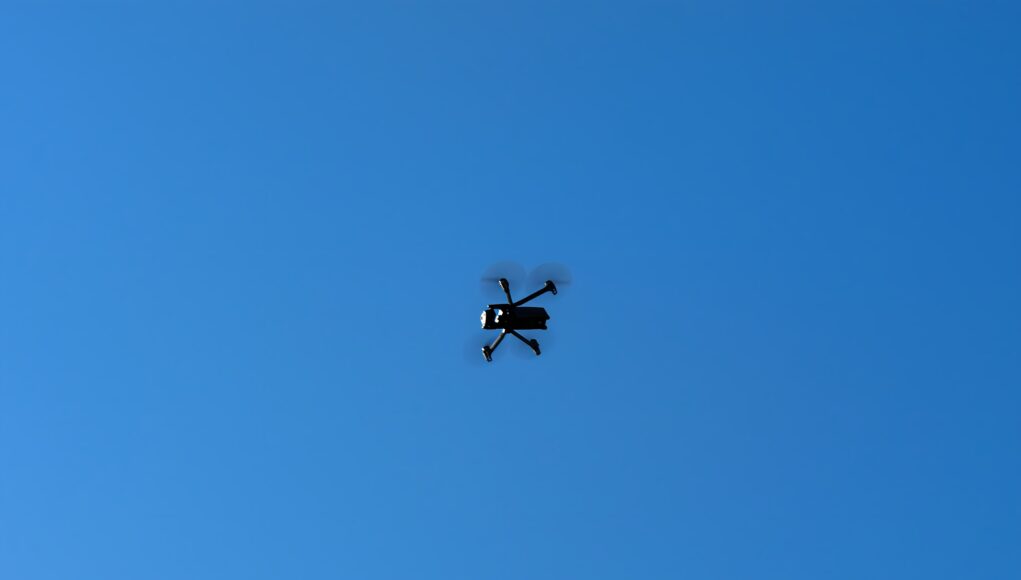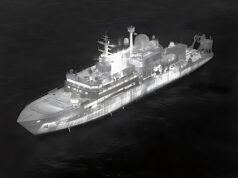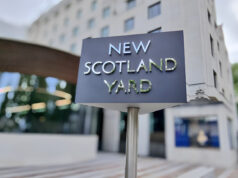On the 1st of June 2025, modern warfare changed.
Ukraine launched Operation Spider Web, a coordinated drone strike deep into Russian territory. Dozens of first-person-view drones were activated from mobile truck platforms hidden across Russia, striking five airbases and reportedly destroying over 40 military aircraft.
These included Tu-95 and Tu-160 strategic bombers, as well as a critical A-50 airborne early warning aircraft.
No missiles. No jets. Just small, inexpensive drones launched from within Russia itself. The estimated damage ran into billions, but the true cost may be in the confidence Russia once had in its ability to defend its own airspace.
It was a stunning demonstration of how modern attacks can bypass traditional defences. It was also a warning.
I often fly drones as part of my work. With full clearance and coordination from the Civil Aviation Authority and Police Scotland, I have filmed Royal Navy warships under construction on the Clyde. The new Type 26 frigates are assembled upriver and then moved downriver for fitting out at a separate yard further along the riverbank.
I remember the day HMS Cardiff was floated out. It was a significant moment for British shipbuilding. The ship was towed slowly downriver, passing crowds of spectators, workers and families who had turned out to watch. The police were there. So were I and other members of the press. My drone was in the air — but it was operating with air traffic control clearance. Police Scotland were aware of my identity and my activities. The shipbuilder had also been informed in advance. Everything was by the book.
But we weren’t the only ones flying.
At least a dozen other drones were in the air. None of them appeared to have permission. All were operating inside Glasgow Airport’s Flight Restriction Zone. And their operators were nowhere to be seen.
Some may have been flying from benches across the river, or from parked cars hidden behind hedges. One drone hovered directly above Cardiff’s flight deck.
To a casual observer, this might have looked like harmless enthusiasm. In fact, many of the drones that day likely belonged to individuals who were simply excited to capture a proud moment. It’s not every day a Royal Navy warship takes to the water, and in fairness, most people flying those drones probably had no ill intent. They were not trying to disrupt or provoke. They just wanted to see history from the air.
But good intentions are not enough.
The reality is that those flights were unauthorised. They took place in restricted airspace and over a sensitive defence asset. Whether deliberate or accidental, the result was the same — the ship was exposed to uncontrolled air activity, and the authorities had limited ability to respond in real time.
This is not just a theoretical concern. It is backed up by data.
Earlier this year, I submitted a Freedom of Information request to Police Scotland. I asked how many drone incidents had been recorded in the area surrounding a number of shipyards since January 2020. Their response revealed that 99 drone-related incidents had been reported within the Flight Restriction Zone during that period.
Only four of those incidents resulted in crime reports, and only two led to detected crimes, where a suspect was identified and a report submitted to the Crown Office. In both of those cases, the drones were confiscated.
That is a detection rate of just two percent. Police Scotland also noted that not every incident is accurately geotagged, and that some reports may have gone unrecorded or were not linked to specific postcodes. In other words, the real number of drone flights in restricted airspace is likely even higher.
This is a clear vulnerability. The UK’s response to emerging drone threats has largely been intelligence-led. The emphasis has rightly been on monitoring intent, tracking individuals or groups who may pose a threat, and preventing attacks before they occur. That approach has worked in many cases, particularly where hostile reconnaissance or repeat suspicious flights have drawn attention.
But intelligence, however good, can only take us so far. A lone individual with no record, a second-hand drone bought online, and an improvised payload does not raise flags in advance. No warning lights go off. The drone can be launched from a quiet park or layby, flown into a target within minutes, and leave no trail to follow. It is low-cost, low-signature and high-impact — and that changes everything.
The person flying over Cardiff that day was not standing beside the police. They were hidden. If they had been flying something more dangerous than a camera drone, there would have been no warning and no way to intercept in time.
Operation Spider Web should change how we think about this threat.
Ukraine proved that drones can bypass layered air defences and cripple high-value targets. They showed that low-cost technology, when used creatively and with intent, can inflict massive damage. It does not require a military budget. It requires a plan and patience.
If Ukraine can hit Russian strategic bombers parked at airbases deep inside the country, what is to stop someone from doing the same to a frigate during its fitting out? Or to an airliner at a civilian terminal? Or to critical infrastructure during a public event?
A brief but important disclaimer. I had no intention of writing about drone activity near one particular yard, because this issue is not specific to any single site or company. This is not about any one facility or the people who work there. It is simply the place where I have personally witnessed the problem. But I have seen the same issue elsewhere — drones flying near the naval base in Portsmouth as a carrier departed, near Babcock’s yard in Rosyth, near RAF Waddington during an exercise. It is a national concern, not a local one. What makes it timely is the reality now demonstrated by Ukraine. It is no longer paranoid to consider these scenarios. It is responsible.
Britain needs to treat this with the seriousness it deserves.
We need a national drone security strategy that includes stronger enforcement, better detection, and clearer authority for police to act in real time. We need to install counter-drone systems not just at airports but near industrial sites, ports, and public buildings. And we need to educate the public about where they can and cannot fly.
This cannot wait. The next hostile drone will not come with a warning. Its pilot will not be standing in the open. He will be behind a wall or downriver in a parked car, out of sight. And by the time we notice, it may already be too late.













Quoting someone off X here, but summed it up for me-
Airfields, air defenses, munitions storages, training grounds, barracks, factories, trains. None are safe. Simply park near your target and you are largely unstoppable at current.
They planned the operation in one of the buildings next to the FSB….
A drone attack, whether it’s on a defence establishment or any other place in the UK, is a terrorist event. We can’t protect every site from Parliament to Prestwick, Meadowhall to Manchester Arena, from Warton to Waterloo Barracks. We can and must protect critical operational sites, but we can’t protect everywhere until we can monitor everywhere, and have AI checking for suspicious activity, as no human can do it.
I agree
And as George has mentioned that people being able to easily fly drones over sensitive areas means we are wide open for sabotage from a drone in the truck, or the man in the bushes.
You just have to look at the wave of drones that were flying over one of the US bases earlier this year, night after night and the US was unable to deal with them, even though they suspected it was a foreign actor.
I suspect the threat won’t be fully counted for a fair few years, as anti jamming tech and AI makes the drones harder and harder to handle.
“This cannot wait. The next hostile drone will not come with a warning. Its pilot will not be standing in the open. He will be behind a wall or downriver in a parked car, out of sight. And by the time we notice, it may already be too late.”
Many good points raised. There see to be three threat conditions:
1) You’ve got the peacetime “some terrorist or state-sponsored saboteurs sneaks a drone in and damages an important asset.” This is potentially hurtful but it isn’t existential, and one imagines security would ramp after significantly after the threat. Going full police state on drones now, however, might be an over-reaction and politically unacceptable. Probably what is most important is to have security at critical infrastructure trained as to what to in the event of a major drone attack, rather than just sit there, film it, and investigate later. But I think it’s less serious than:
2) You’re in the middle of a drone war, the enemy are also doing spec ops strikes, but you neglect to secure critical airbases from the combination of the two, as Russia failed to do. This obviously needs action to make the UK forces have the necessary trained assets in place to activate and sustain an anti-drone plan in the event of a crisis or during a war, both against infiltrators with drones (as per Ukraine-Russia) and off-shore attack (e.g., off a merchant ship, fishing boat, etc.) I think this is what one needs to be looking at as the biggest priority.
3) Third and most difficult is the bolt-from-the-blue Pearl Harbor attack intended as a decapitation strike. This is the trickiest one and basically seems to require close cooperation between intelligence serves to rapidly activate wartime counter-drone protocols.
It’s missing the point a bit.. this was called spider because a was a mass of different sabotage acts across the country.. the most interesting used shipping containers and commercial logistic companies and drones as to tool for sabotage…
What this is is the Maoist concept of political warfare as part of protracted warfare.. when fighting a protracted war you use every possible way to harm your enemy and cause them pain. sabotage, terrorist attacks, political assassinations, cyber, information warfare.. using commercial shipping and land logistics routes to get automated containers full of drones.. 2000km into a territory..
Who cares if you loss a battle, if you can then launch a mass sabotage that destroys billions of pounds of irreplaceable strategic assets.. and has every leader in fear of imminent death… when the peace talks come all that matters is how much pain and damage you inflicted not how you did it…
The west needs to wake up to this fast… because that is how China will fight a war and Russia has been doing it to us for a while on a lesser scale.. and the main theory behind politics warfare in protracted war is that as you start your kinetic war you hit them with massive levels of political warfare ( mass terror attacks, mass sabotage, mass cyber, mass assassinations, mass information warfare)… to cause significant disruption.. then you keep the pain going.
(Aircraft and radars are of course most vulnerable, as they can be destroyed rather than just damaged, by a single small drone, but as the poster indicates, one also wants to protect ships or any other crucial assets. One would hope there is a classified study as to what points the most damage small FPV or autonomous drones with a relatively small payload can inflict on a variety of targets, whether military or civilian (power, communications, railway, etc) and to ensure that there are also redundancies or security protocols in place so that a sudden attack does not result in a catastrophic outcome)
Need more covert sites.
Need more stuff underground, money spent on hardening like at Cold War levels.
A FPV drone is surely not hitting those targets.
Essentially a very robust structure.. assume the enemy will attack anything and everything with any unconventional means at their disposal.. even the CND peace women were essentially unconventional attacks.. If I was planning to attack the Uk, first thing I would do is subvert every pressure group and have them organise mass protests and direct action on the day I was planning to attack.. an airbase that has a security team that is streatched dealing with a load of peace protesters attacking the fences is open to sabotage etc etc… if I was truly brutal I would get 100,000 people protesting and drop a bomb on them…to overwhelm the casual response and hospitals so when I then went for the munition factory and military bases the medical response would bot be there..once you have had a good read of Mao you realise any type of attack is possible.. after all we all know one of the reasons the US probably dropped 2 A bombs on Japan was to warn the Russians off.
The reality is that our enemies are already putting these things in place. Police have stated that the Iranians (IRG agents) were actively agitating the weekly London pro Hamas marches. EU allies already uncovered at least one iranian backed terror cell with an arms warehouse in Bulgaria and planning mass shooting attacks. And that’s just Iran. Then there’s Russia and their propensity for sabotage. The number of electricity sub station fires near to ports and business/retail parks this year is already over a dozen, Heathrow being the highest profile example. And we are seeing endless successful cyber attacks, were anyone could be manipulating the groups of hackers as to which targets they’re choosing.
Meanwhile terrorism has been relatively quiet, but why did the Southport attacker suddenly pivot from attacking his old school (as he was prevented from doing by his father the week before) to attacking an event outside his Borough, mirroring a planned attack that was thwarted in Vienna, also involving the production of chemical weapons. We are living in dangerous times and the government needs to urgently ramp up. Including public awareness campaigns.
Agree HAS can protect the frontline jets, but the UK bases will need significant investment in that area, ditto ECM/ ECCM jammers and you have to state even just the trust worthy shotgun should prove effective.
The UKs GBAD needs urgent attention this innovative and wildly successful drone strike will in the future be talked about along the same lines as the FAA attack on Taranto or the Japanese attack on Pearl Harbour.
Radar guided guns and dragon fire types of directed energy weapons are all possible solutions to the drone threat.
Aircraft on approach or just taking off aren’t safe either. Drones could be flown into the windshield or fly into the engines.
There is a world of diference between attacking aircraft made out of thin aluminium where a small amount of explosive can do terminal damage and something made out of steel plate with multiple compartments like a ship where it can’t.
Except, there are many exposed parts of a ship that can be attacked. For example, radars, antennas, engine intakes/exhausts, etc. Crashing enough into the hanger could destroy the helicopter(s) causing fires and other damage.
None of which which sink the ship, but it cause enough damage to take her out of the fight until repairs could be made.
Small FPV drones can have HEAT grenades, if the intention is to penetrate any ship hull (even HMS Belfast) there will not be any problem, you can also make a hole large enough with various impacts with different explosive types and then follow up with another drone to inside the ship.
But that complexity is not necessary as Collins says all radar antenna is exposed, VLS cells etc.
Very large complex AAW cruises have in the past been mission killed by small blast frag warheads.. infact the U.S. managed to mission kill one of its own cruisers with a near miss blast frag warhead from a shrike missile.
Lots of oversized cricket nets are needed!!
Nets had occurred to me as well.
Shotguns..lots and lots of old duffers with shotguns.
Ukrainians actually make good use of the nets to trap any drones, Many made by volunteers
And cover various area’s
So yep they do work
I think for critical sites and for key military bases we need very robust and effective VSHORAD systems. Probably just radar guided guns or net throwers or jammers or ideally a combination of those things.
The UK must harden itself against such an attack design simply by being prepared to counter it and through much more robust infrastructure such as HAS for aircraft, netting over large parked up and dispersed aircraft. It’s telling that the Russian aircraft were all just parked up in nice long lines on the airfield apron and were sitting ducks. £7 billion of irreplaceable air raft lost. That’s going to really really piss of Mad Vlad.
So yes RAF needs to learn from this Poseidon, Wedgetails, A400, Voyager tankers all now need to be dispersed and under covering multi layered netting. That’s the cheapest way to protect them from a drone strike that penetrates the SHORAD , GBAD systems the UK most definitely requires urgently under an UOR criteria. This needs to be a crash programme and sorted out in weeks and months not years and decades.
The thing is and this may be laughable..but actually home guard, civil defence and conscription do give you robustness to managed a peer war..
In the end peer wars are not just about sending professional soldiers to fight and die and they are not over in weeks or months.. it will be about the nation and national infrastructure over years… China does get this, that’s why it has 100 million members of the communist party, 5 million paramilitary security forces and 3 million political warfare operatives…
When we fight a peer war social cohesion, security, protection of strategic infrastructure, food, water, power, transport, health, manufacturing, government and defence will all be utterly critical and it will need a lot of people to defend it and keep it all running..
Very good article. We need automated and large scale AI SHORAD on steroids all over the country. You can’t expect to man all of these 24/7 so it needs to be deploy and forget , something like Ukraine’s Sky Sentinel drone defence gun turret, later may be laser? We needs 1000s of these rapidly created and then hopefully we get scale costs. Bit like the auto guns in Aliens.